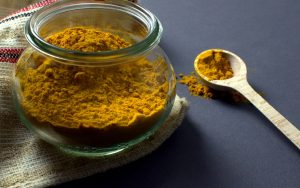
Add turmeric to your diet to improve your well-being
By Christie Melhorn, March 23 2018 –
In the past few weeks, my social media feeds have been decorated by posts of yellow foamy lattes in rustic mugs and mason jars. These fad beverages get their tint from the spice turmeric. If you’re unfamiliar with turmeric, it gives mustard its distinct bright colour and subtle bitter flavour — you’ve probably tried it in a yellow curry dish. Raw turmeric looks like strange, gnarled toes but also comes ground. It’s versatile ingredient that boasts many health benefits, making it worthwhile to add to your diet — not to mention its aesthetically pleasing quality. Here’s why you should make your pantry home to the spice.
According to a University of Texas study, turmeric helps regulate the production of thymus and bone marrow cells that are vital in the immune response. It’s also correlated with enhancing antibody function when invasive properties enter your system. Eating turmeric-rich food could help decrease the frequency of colds during the semester and fend one off when symptoms arise.
Anti-inflammatory:
Kris Gunnars of the health-care blog Authority Nutrition says that turmeric is rich in a powerful anti-inflammatory called curcumin. Gunnars says that curcumin is equally as effective at fighting inflammation as pharmaceuticals — but without the nasty headaches and stomach pain that they typically cause.
Anti-depressant:
Trying to secure solid grades while paying rent, working a job outside of school and the general pressures of student life can be overwhelming. Andrew Wiel, director of integrative medicine at the University of Arizona, says that turmeric is linked with nerve growth in the brain’s frontal cortex, which is responsible for many functions, including emotional processes. It’s also associated with producing the feel-good neurotransmitters dopamine and serotonin. While it can’t cure depression, these subtle changes in your nutrition can help create in a shift in your mood and approach in daily life.
Clears skin:
At some point, almost everyone experiences some kind of stress-induced break-out or skin condition. When applied topically, turmeric’s anti-inflammatory properties can help reduce epidermal swelling and irritation. A few months ago, I used a turmeric paste to treat a stye and it seemed to help. If anything, making and applying it was relaxing and forced me to slow down for a few minutes. For some turmeric skin-treatment recipes, click here.
Turmeric is sold at most grocery stores and markets. When buying it ground, check the ingredients list first. Unnecessary fillers that are often added can negate some of its health benefits. When possible, try to get turmeric in its purest form.

